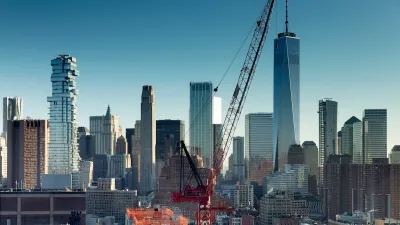The cautionary tale of “a very suburban kerfuffle” in Blaine, Minnesota: residents of a “large, multi-builder housing development” who once opposed a multi-family residential development in the neighborhood now lament a lack of retail.
Julie Kosbab makes the “you reap what you sow” argument regarding density (or lack thereof) by telling the story of “The Lakes” development in Blaine, Minnesota.
“Within a large, multi-builder housing development, there were several commercial plots. Despite the housing boom in the area, no one would step up to develop them as commercial, because no one wanted to occupy a potentially developed property.” The reticence of developers to build commercial uses in The Lakes is explained by a lack of density, for which residents have no one to blame but themselves, according to Kosbab.
“[One] of the biggest protests in Blaine City Council history was when a builder proposed a 157-unit luxury apartment complex on a nearby plot.” And you can probably guess what happened next: “Due to neighborhood protest, the plan for this added density was shot down.”
“Now, many of the same residents who opposed the apartments are shrieking that they were 'misled' because they were prooooomised retail! And now those mean builders want to build more homes instead!”
The lesson, according to Kosbab: “Even small retail with high-end appeal (childcare? yoga? coffee?) requires a degree of density to support the cost of the property and reasonable financials.”
FULL STORY: Accept the Consequences of Opposing Density

Americans May Be Stuck — But Why?
Americans are moving a lot less than they once did, and that is a problem. While Yoni Applebaum, in his highly-publicized article Stuck, gets the reasons badly wrong, it's still important to ask: why are we moving so much less than before?

Using Old Oil and Gas Wells for Green Energy Storage
Penn State researchers have found that repurposing abandoned oil and gas wells for geothermal-assisted compressed-air energy storage can boost efficiency, reduce environmental risks, and support clean energy and job transitions.

Placekeeping: Setting a New Precedent for City Planners
How a preservation-based approach to redevelopment and urban design can prevent displacement and honor legacy communities.

San Francisco’s Muni Ridership Grew in 2024
The system saw its highest ridership since before the Covid-19 pandemic, but faces a severe budget shortage in the coming year.

Colorado Lawmakers Move to Protect BRT Funding
In the face of potential federal funding cuts, CDOT leaders reasserted their commitment to planned bus rapid transit projects.

Safe Streets Funding in Jeopardy
The Trump administration is specifically targeting bike infrastructure and other road safety projects in its funding cuts.
Urban Design for Planners 1: Software Tools
This six-course series explores essential urban design concepts using open source software and equips planners with the tools they need to participate fully in the urban design process.
Planning for Universal Design
Learn the tools for implementing Universal Design in planning regulations.
Heyer Gruel & Associates PA
City of Moreno Valley
Institute for Housing and Urban Development Studies (IHS)
City of Grandview
Harvard GSD Executive Education
Salt Lake City
NYU Wagner Graduate School of Public Service
City of Cambridge, Maryland





























